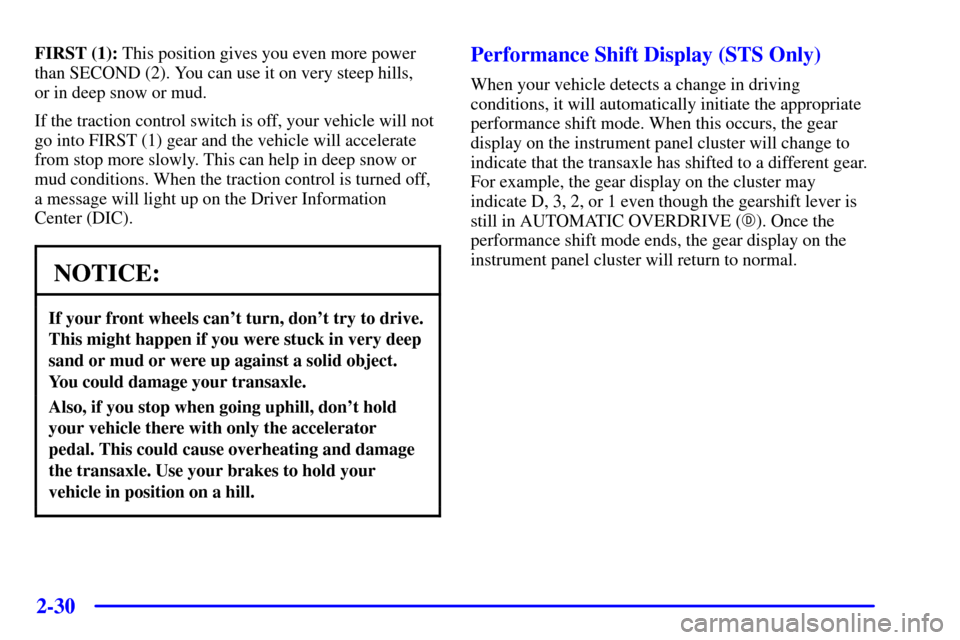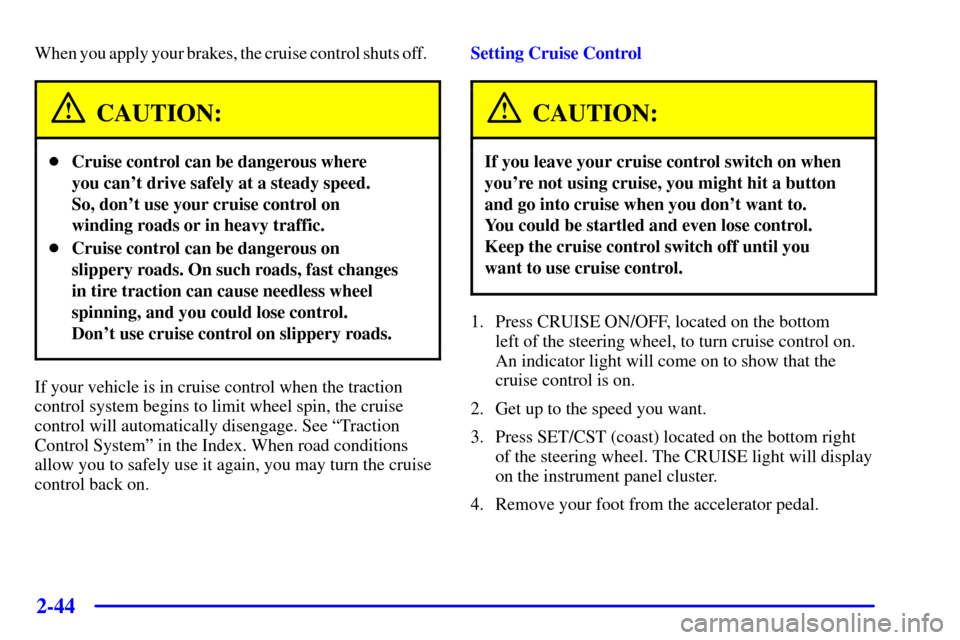Page 87 of 399

2-30
FIRST (1): This position gives you even more power
than SECOND (2). You can use it on very steep hills,
or in deep snow or mud.
If the traction control switch is off, your vehicle will not
go into FIRST (1) gear and the vehicle will accelerate
from stop more slowly. This can help in deep snow or
mud conditions. When the traction control is turned off,
a message will light up on the Driver Information
Center (DIC).
NOTICE:
If your front wheels can't turn, don't try to drive.
This might happen if you were stuck in very deep
sand or mud or were up against a solid object.
You could damage your transaxle.
Also, if you stop when going uphill, don't hold
your vehicle there with only the accelerator
pedal. This could cause overheating and damage
the transaxle. Use your brakes to hold your
vehicle in position on a hill.
Performance Shift Display (STS Only)
When your vehicle detects a change in driving
conditions, it will automatically initiate the appropriate
performance shift mode. When this occurs, the gear
display on the instrument panel cluster will change to
indicate that the transaxle has shifted to a different gear.
For example, the gear display on the cluster may
indicate D, 3, 2, or 1 even though the gearshift lever is
still in AUTOMATIC OVERDRIVE (�). Once the
performance shift mode ends, the gear display on the
instrument panel cluster will return to normal.
Page 101 of 399

2-44
When you apply your brakes, the cruise control shuts off.
CAUTION:
�Cruise control can be dangerous where
you can't drive safely at a steady speed.
So, don't use your cruise control on
winding roads or in heavy traffic.
�Cruise control can be dangerous on
slippery roads. On such roads, fast changes
in tire traction can cause needless wheel
spinning, and you could lose control.
Don't use cruise control on slippery roads.
If your vehicle is in cruise control when the traction
control system begins to limit wheel spin, the cruise
control will automatically disengage. See ªTraction
Control Systemº in the Index. When road conditions
allow you to safely use it again, you may turn the cruise
control back on.Setting Cruise Control
CAUTION:
If you leave your cruise control switch on when
you're not using cruise, you might hit a button
and go into cruise when you don't want to.
You could be startled and even lose control.
Keep the cruise control switch off until you
want to use cruise control.
1. Press CRUISE ON/OFF, located on the bottom
left of the steering wheel, to turn cruise control on.
An indicator light will come on to show that the
cruise control is on.
2. Get up to the speed you want.
3. Press SET/CST (coast) located on the bottom right
of the steering wheel. The CRUISE light will display
on the instrument panel cluster.
4. Remove your foot from the accelerator pedal.
Page 128 of 399
2-71
The main components of the instrument panel are the following:
A. Air Outlets
B. Driver Information Center (DIC) Buttons
C. Turn Signal/Multifunction Lever
D. HVAC Steering Wheel Controls
(or Cellular Telephone Controls, If Equipped)
E. Instrument Panel Cluster
F. Windshield Wiper/Washer Lever
G. Audio Steering Wheel Controls
H. Ignition Switch
I. Air Vent Control Thumbwheel
J. Hazard Warning Flasher Button
K. Audio SystemL. Exterior Lamp Controls
M. Hood Release
N. Fuel Door Release
O. Trunk Release
P. Cruise Control
Q. Horn
R. Heated Seat Controls
S. Traction Control Switch
T. Console Shift Lever
U. Convenience Storage/Optional Ashtray
V. Climate Controls
W. Glove Box
Page 136 of 399

2-79 Anti-Lock Brake System Warning Light
With the anti-lock brake
system, the light(s) will
come on when your
engine is started and may
stay on for several seconds.
That's normal.
If the light stays on, turn the ignition to OFF. Or, if the
light comes on when you're driving, stop as soon as
possible and turn the ignition off. Then start the engine
again to reset the system. If the light still stays on, or
comes on again while you're driving, your vehicle needs
service. If the regular brake system warning light isn't
on, you still have brakes, but you don't have anti
-lock
brakes. If the regular brake system warning light is
also on, you don't have anti
-lock brakes and there's a
problem with your regular brakes. See ªBrake System
Warning Lightº earlier in this section.
The anti
-lock brake system warning light should
come on briefly when you turn the ignition key to ON.
If the light doesn't come on then, have it fixed so it will
be ready to warn you if there is a problem.
Traction Control System Warning Light
United States Canada
This warning light should come on briefly when the
engine is started.
If the warning light doesn't come on then, have it fixed
so it will be ready to warn you if there's a problem.
If it stays on, or comes on when you're driving, there
may be a problem with your traction control system and
your vehicle may need service. When this warning light
is on, the system will not limit wheel spin. Adjust your
driving accordingly.
Page 137 of 399
2-80
The traction control system warning light may come on
for the following reasons:
�If there's a brake system problem that is specifically
related to traction control, the traction control system
will turn off and the warning light will come on.
�If the traction control system is affected by an
engine
-related problem, the system will turn off
and the warning light will come on.
If the traction control system warning light comes on
and stays on for an extended period of time when the
system is turned on, your vehicle needs service.
Engine Coolant Temperature Warning Light
This light tells you that
your engine has overheated.
As a check, the light should
come on for a few seconds
when you start your engine.
If this light comes on and stays on, you should stop
your vehicle and turn the engine off as soon as possible.
A warning chime should also sound if this light comes on.
See ªEngine Overheatingº in the Index.
Page 155 of 399

2-98
TRACTION ENGAGED - 91: When your traction
control system is limiting wheel spin, the TRACTION
ENGAGED message will be displayed. Slippery road
conditions may exist if this message is displayed, so
adjust your driving accordingly. This message will stay
on for a few seconds after the traction control system
stops limiting wheel spin.
TRACTION OFF
- 89: This message will be displayed
after the traction control system has been turned off
using the TRAC ON/OFF button on the center console.
TRACTION READY
- 90: This message informs
the driver that the traction control system is available.
Pressing the TRAC ON/OFF button on the center
console once turns the traction control system off;
pressing the button again turns the system back on.
This message will automatically disappear from the
display after five seconds.TRACTION SUSPENDED
- 56: This message
displays when the traction control system has been
temporarily shut off because your vehicle's brakes have
overheated. This message does not indicate a problem
with your vehicle's traction control system. After a few
minutes, the traction control system will be available
again and the TRACTION READY message will appear.
TRANS HOT IDLE ENGINE
- 112: This message
indicates that the transaxle fluid in your vehicle is too
hot. Stop and allow your vehicle to idle until it cools
down or until this message is removed.
TRUNK OPEN
- 24: This message indicates that
the trunk is open when the ignition is on.
TURN SIGNAL ON
- 20: If you drive your vehicle
for more than a mile with a turn signal on, this message
will appear as a reminder to turn off the turn signal.
A multiple chime will sound when this message
is displayed.
VEHICLE OVERSPEED
- 52: This message is
displayed when the vehicle speed exceeds a certain limit
as required by some export countries. A continuous
chime will sound when this message is displayed.
Page 209 of 399
4-
4-1
Section 4 Your Driving and the Road
Here you'll find information about driving on different kinds of roads and in varying weather conditions. We've also
included many other useful tips on driving.
4
-2 Defensive Driving
4
-3 Drunken Driving
4
-6 Control of a Vehicle
4
-6 Braking
4
-9 Traction Control System
4
-11 Steering
4
-13 Off-Road Recovery
4
-14 Passing
4
-15 Loss of Control
4
-16 Driving at Night4
-18 Driving in Rain and on Wet Roads
4
-21 City Driving
4
-22 Freeway Driving
4
-23 Before Leaving on a Long Trip
4
-24 Highway Hypnosis
4
-24 Hill and Mountain Roads
4
-26 Winter Driving
4
-30 Recreational Vehicle Towing
4
-32 Loading Your Vehicle
4
-34 Towing a Trailer
Page 214 of 399

4-6
Control of a Vehicle
You have three systems that make your vehicle go where
you want it to go. They are the brakes, the steering and
the accelerator. All three systems have to do their work
at the places where the tires meet the road.
Sometimes, as when you're driving on snow or ice, it's
easy to ask more of those control systems than the tires
and road can provide. That means you can lose control
of your vehicle. Also see ªTraction Control Systemº in
the Index.
Braking
Braking action involves perception time and
reaction time.
First, you have to decide to push on the brake pedal.
That's perception time. Then you have to bring up
your foot and do it. That's reaction time.
Average reaction time is about 3/4 of a second. But
that's only an average. It might be less with one driver
and as long as two or three seconds or more with
another. Age, physical condition, alertness, coordination
and eyesight all play a part. So do alcohol, drugs and
frustration. But even in 3/4 of a second, a vehicle
moving at 60 mph (100 km/h) travels 66 feet (20 m).
That could be a lot of distance in an emergency, so
keeping enough space between your vehicle and others
is important.
And, of course, actual stopping distances vary greatly
with the surface of the road (whether it's pavement or
gravel); the condition of the road (wet, dry, icy); tire
tread; the condition of your brakes; the weight of the
vehicle and the amount of brake force applied.